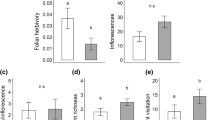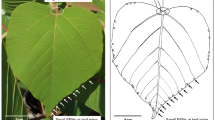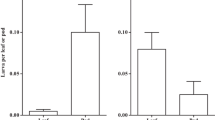Abstract
Many plants secrete nectar from extrafloral nectaries (EFNs), specialized structures that usually attract ants which can act as plant defenders. We examined the nectar-mediated interactions between Chamaecrista nictitans (Caesalpineaceae) and jumping spiders (Araneae, Salticidae) for 2 years in old fields in New Jersey, USA. Previous research suggests that spiders are entirely carnivorous, yet jumping spiders (Eris sp. and Metaphidippus sp.) on C. nictitans collected nectar in addition to feeding on herbivores, ants, bees, and other spiders. In a controlled-environment experiment, when given a choice between C. nictitans with or without active EFNs, foraging spiders spent 86% of their time on plants with nectar. C. nictitans with resident jumping spiders did set significantly more seed than plants with no spiders, indicating a beneficial effect from these predators. However, the presence of jumping spiders did not decrease numbers of Sennius cruentatus (Bruchidae), a specialist seed predator of C. nictitans. Jumping spiders may provide additional, unexpected defense to plants possessing EFNs. Plants with EFNs may therefore have beneficial interactions with other arthropod predators in addition to nectar-collecting ants.
Similar content being viewed by others

Author information
Authors and Affiliations
Additional information
Received: 27 May 1998 / Accepted: 23 December 1998
Rights and permissions
About this article
Cite this article
Ruhren, S., Handel, S. Jumping spiders (Salticidae) enhance the seed production of a plant with extrafloral nectaries. Oecologia 119, 227–230 (1999). https://doi.org/10.1007/s004420050780
Issue Date:
DOI: https://doi.org/10.1007/s004420050780



